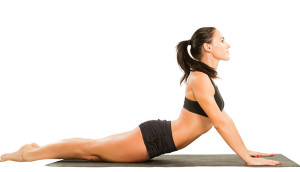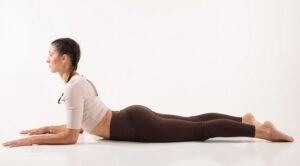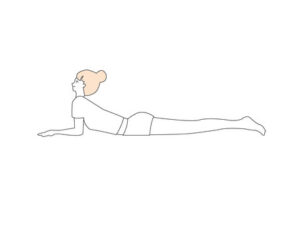

If you spend a lot of time sitting at a desk or hunched over your phone, you might have noticed that your head tends to lean forward more than it should.
This “forward head position” is a common postural issue in today’s tech-driven world. Over time, this can cause neck pain, tension headaches, and poor posture.
Thankfully, yoga offers a solution to this modern-day problem, and one pose, in particular, is highly effective in addressing it: Sphinx Pose.
Known in Sanskrit as Salamba Bhujangasana, the Sphinx Pose is a gentle backbend that targets the spine, shoulders, and neck.
While it is often used to relieve tension in the lower back, it is also an excellent tool for correcting forward head posture.
In this article, I shall explore how to use Sphinx Pose to realign your neck and fix that problematic forward head position.
I will also look at how this simple yet powerful pose can be a game-changer for anyone struggling with poor posture due to prolonged sitting or tech use.
“How to Fix Forward Head Position with Sphinx Pose” Article Index:
- What is Forward Head Position?
- Why Sphinx Pose is Effective for Forward Head Correction
- How to Perform Sphinx Pose (Salamba Bhujangasana)
- The Benefits of Sphinx Pose in Fixing Forward Head Position
- Variations of Sphinx Pose to Deepen the Stretch
- Incorporating Sphinx Pose into Your Daily Routine
- Conclusion: Using Sphinx Pose to Fix Forward Head Position
What is Forward Head Position?
Forward head position occurs when your head is shifted in front of your body’s vertical midline, putting undue strain on your neck and shoulders.
For every inch your head moves forward, the weight your neck must support doubles.
This misalignment can cause various physical issues, such as neck pain, upper back tension, and even headaches.
Most of us fall victim to this postural issue due to prolonged sitting, especially when working at a computer or using a phone.
The problem with forward head position is that it often goes unnoticed until the discomfort sets in.
You may not even realize your head is tilted forward until you see yourself in a side profile.
That is why it is important to adopt corrective strategies before the damage becomes severe, and yoga, specifically Salamba Bhujangasana (Sphinx Pose), is one of the most accessible and effective tools for this purpose.
Why Sphinx Pose is Effective for Forward Head?
Sphinx Pose is a gentle backbend that counteracts the forward rounding of the upper body, making it an ideal posture to address forward head position.
This pose helps by realigning the neck and encouraging the natural curve of the cervical spine.
When practiced regularly, it can help retrain the muscles around the neck, upper back, and shoulders to support proper alignment.
Unlike other intense backbends, Sphinx Pose is accessible for all levels, making it easy to incorporate into your daily routine.
It is also often referred to as Naraviralasana, emphasizing its calming, restorative nature.
By gently engaging the back muscles and elongating the neck, Sphinx Pose works as a mild but effective stretch to reverse the slouching habits that lead to forward head posture.
How to Perform Sphinx Pose (Salamba Bhujangasana)?
Performing Salamba Bhujangasana correctly is essential for reaping its full benefits in fixing forward head posture. Here’s a step-by-step guide to doing it right:
- Lie on your stomach: Begin by lying flat on your belly with your legs extended behind you and your feet hip-width apart. Let the tops of your feet rest on the mat.
- Position your forearms: Place your forearms on the mat in front of you with your elbows directly under your shoulders. Your forearms should be parallel to each other, and your fingers spread wide for stability.
- Lift your chest: As you inhale, gently press through your forearms and lift your chest off the floor. Keep your lower ribs on the mat and avoid pushing too hard.
- Engage your core and back: Lightly engage your abdominal muscles to protect your lower back, and activate the muscles in your upper back to prevent your shoulders from rounding forward.
- Lengthen your neck: Tuck your chin slightly to create length in the back of your neck. Focus on aligning your head with your spine, keeping your gaze forward or slightly downward.
- Hold the pose: Stay in Sphinx Pose for 5-10 breaths, feeling the stretch in your upper back and the activation of your neck muscles.
- Release gently: To come out of the pose, exhale and slowly lower your chest back down to the mat. Rest your forehead on your hands and take a few deep breaths.
The Benefits of Sphinx Pose in Fixing Forward Head Position
The benefits of Sphinx Pose extend beyond just being the best forward head posture fix. It is a highly effective way to engage the muscles that are often weak or overstretched due to forward head position.
Here are some key benefits:
- Strengthens the upper back: Sphinx Pose activates the trapezius and rhomboid muscles, which play a crucial role in pulling the shoulders back and supporting the neck. By regularly performing this pose, you can counteract the effects of prolonged slouching.
- Stretches the chest: Forward head posture is often accompanied by tight chest muscles. Sphinx Pose opens up the chest, helping to release tension in the pectoral muscles and allowing your shoulders to relax back into a more neutral position.
- Encourages cervical alignment: One of the main benefits of Sphinx Asanay is its ability to promote proper neck alignment. By engaging the neck muscles and creating a gentle stretch along the spine, Sphinx Pose helps reposition the head directly over the spine.
- Promotes relaxation: Practicing Sphinx Pose also has a calming effect, which is why it is commonly included in restorative and yin yoga practices. The benefits of Sphinx Pose in Yin Yoga include its ability to reduce stress and tension in the neck and shoulders—two areas commonly affected by poor posture.
Variations of Sphinx Pose to Deepen the Stretch
While the basic Sphinx Pose is powerful on its own, there are a few variations you can try to deepen the stretch and further target the neck and upper back:
- Extended Sphinx Pose: To take the stretch further, you can walk your hands slightly forward, lifting your chest higher and increasing the arch in your upper back. Be mindful not to overextend your lower back.
- Supported Sphinx Pose: For a more restorative experience, you can place a bolster or pillow under your chest and forearms, turning the pose into a restorative Sphinx Pose. This allows you to hold the pose for longer periods without straining, making it a great option for gently correcting forward head posture.
- Sphinx with Neck Rotation: While in Sphinx Pose, gently turn your head to one side, holding for a few breaths before switching to the other side. This variation helps to release tension in the neck and realign the cervical spine.
Incorporating Sphinx Pose into Your Daily Routine
To effectively fix forward head posture, it is important to incorporate Salamba Bhujangasana into your daily routine.
Aim to practice this pose at least once a day, especially if you spend long hours sitting or looking at screens.
Pairing Sphinx Pose with other neck-strengthening exercises, like chin tucks or shoulder blade squeezes, can enhance its effectiveness.
You can also integrate Sphinx Pose into your evening wind-down routine.
Since it is a calming pose, it works well as part of a restorative Sphinx pose practice before bedtime to release any built-up tension in the neck and upper back.
Final Call on Using Sphinx Pose to Fix Crane Neck Position
In conclusion, Sphinx Pose is a simple yet powerful yoga posture that can help correct forward head position, a common issue in today’s tech-dependent world.
By regularly practicing Salamba Bhujangasana, you can strengthen the muscles in your upper back and neck, allowing your head to realign with your spine.
The pose gently stretches the chest and realigns the cervical spine, making it a key tool in the fight against poor posture.
The benefits of Sphinx Pose extend far beyond just physical alignment; it promotes relaxation and helps relieve tension that often accumulates in the neck and shoulders due to poor posture.
By incorporating this pose into your daily routine and focusing on proper technique, you will be well on your way to fixing forward head posture and improving your overall posture.
References:


